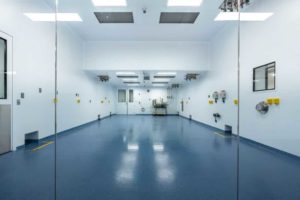
Use of automated cell processors in cleanrooms can save space and money while increasing production capacity. DPS Group took part in the renovation of 650 Pleasant St. in Watertown including 13 cGMP suites for Arranta Bio. Credit: Photo courtesy of Arranta Bio
According to the Massachusetts Biotechnology Council 2022 Industry Snapshot, venture capital funding of the biopharma industry remained strong in 2022 with the first six months of the year boasting $5 billion invested in Massachusetts-headquartered biopharma companies. The strength of the Massachusetts early-stage ecosystem has translated into a drug development pipeline for Massachusetts-headquartered companies that outpaces all but one competitor state, representing 15.6 percent of the U.S. pipeline and a nearly 25 percent increase in drug candidates over last year’s snapshot.
One of the new therapies that have emerged at the forefront of the Massachusetts biopharma pipeline is cell therapy. Cell therapy manufacturing is unique in that it’s personalized medicine, specific to each patient, requiring specialized manufacturing space for the delivery of safe and effective therapies. Traditional cell therapy processes involve significant manual operations, equipment configurations with varying durations of each process step, and multiple batches running simultaneously.
Conducting throughput analyses can determine the optimal equipment required for meeting target production goals. This can then be translated into the right amount of space required for a cell therapy facility while optimizing capital expenditures.
Cleanrooms Vital to Tenants
Most cell therapy manufacturers employ extensive use of biosafety cabinets (BSCs) for production to maintain quality control. There is an inherent risk in open operations that are carried out in BSCs and an enhanced room classification is required to ensure product sterility.
Recently, cell therapy manufacturers have shifted to using Automated Cell Processors (ACPs) and cleanroom isolators to replace BSCs, by physically closing operational steps while dedicated open operations are carried out inside isolators.
ACPs offer the advantage of combining multiple cell processing steps into a single equipment. This leads to a reduction in footprint as well as an enhanced safety profile as the product is no longer exposed to operators or the environment. Due to the closed nature of the processing, the cleanroom classification can also be reduced using this approach.
One of DPS’s recent cell therapy projects employed BSCs in the process, while another employed ACPs and isolators. Both processes had similar operation times. The first project (using BSCs) could process about 70 patients per year per 1,000 square feet of class B manufacturing space. The second project (using isolators) could process about 370 patients per year per 1,000 square feet of class C manufacturing space.
The benefit of using ACPs and isolators is clear as the cost savings of designing, building and operating a class C clean room as compared to class B clean room are significant while at the same time processing about five times the number of patients.
A Study in Optimal Equipment Strategy
A client is building a cell therapy facility to fight solid tumors. The facility uses isolators and ACPs to carry out the operations for the patient-specific process.
DPS was tasked with finding an optimal equipment strategy to maximize utilization of space and minimize fixed costs while processing 500 batches per year. A throughput analysis was developed considering a process duration of 12 days and an annual facility production time of 300 days. A single ACP can process about 24 batches a year, which implies that 21 ACPs would be needed to process 500 batches.
With multiple batches running simultaneously and to eliminate the potential of cross-contamination, 21 isolators would be required to keep one dedicated per batch. This is effectively an ACP to isolator ratio of 1:1, with the ACP utilization of about 70 percent and the isolators about 10 percent and with about 2,300 square feet of cleanroom area required.

Ankur Shah
This configuration is not ideal as expensive equipment, such as isolators, are idle for extended durations. Adjusting batches temporally, by initiating batches at different time points, led to an improvement in equipment utilization and allowed for a reduction in the fixed equipment required.
At the end of the throughput analysis, we were able to reduce the number of ACPs required from 21 to 18 and the number of isolators to just five. This adjusted configuration would occupy approximately 1,100 square feet of cleanroom area, a reduction of approximately 52 percent.
The economic impact of operating times from a facility design perspective can be evaluated from these results. For example, ACPs cost approximately $150,000 each and isolators for such an application would be $300,000 each. By carrying out throughput analyses, we were able to reduce the upfront capital costs from $10 million (for 21 ACPs and 21 isolators) to approximately $4.2 million, an overall savings of 58 percent.
Conducting a throughput analysis can assist in right-sizing the space required for your cell therapy facility to avoid wasting time, space and money.
Ankur Shah is a lead process engineer with DPS Group.




